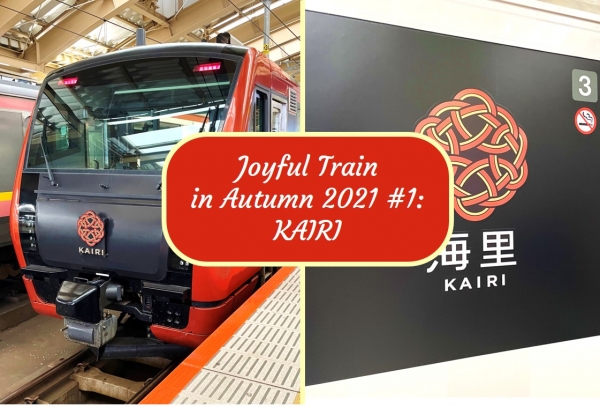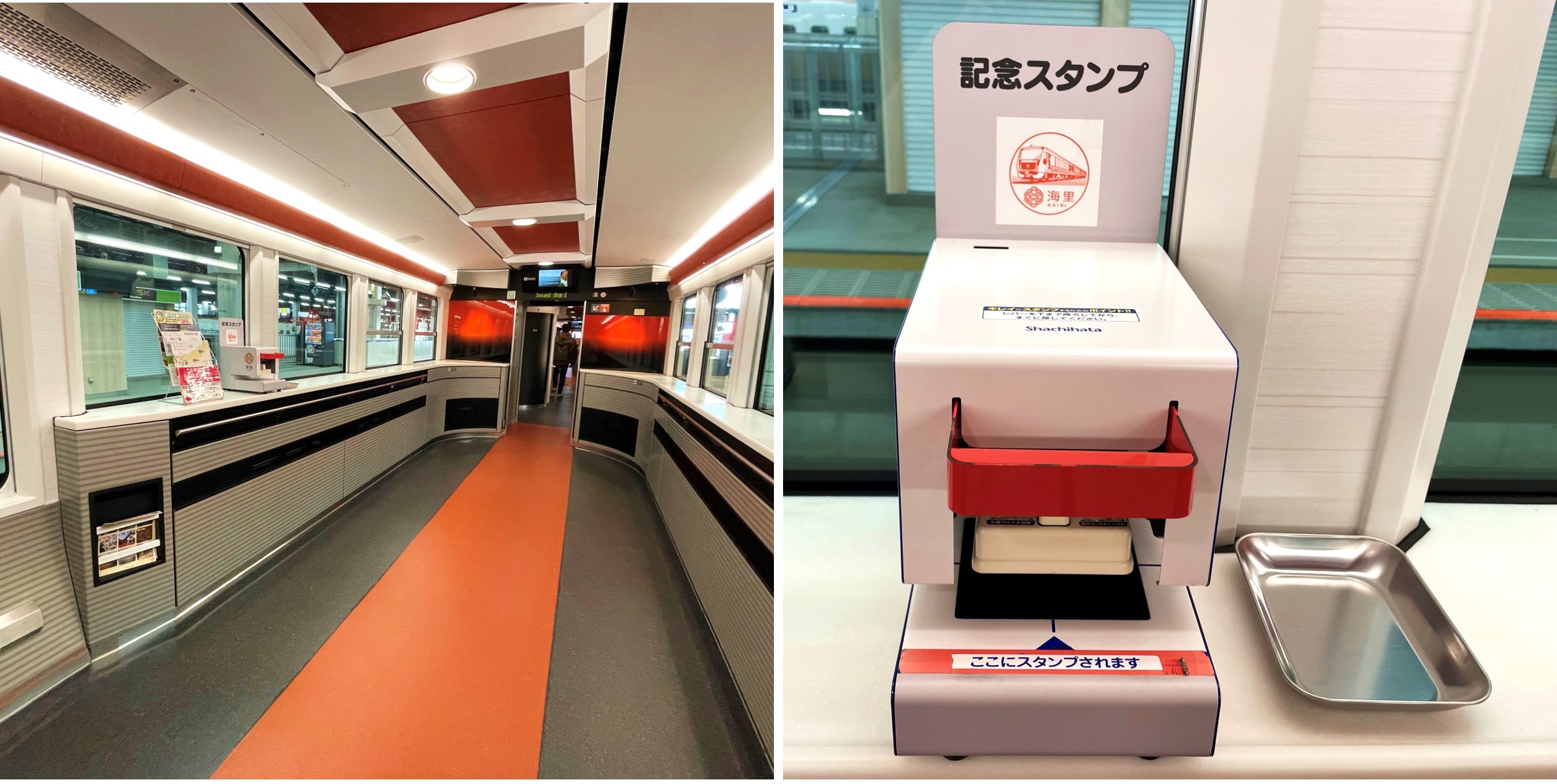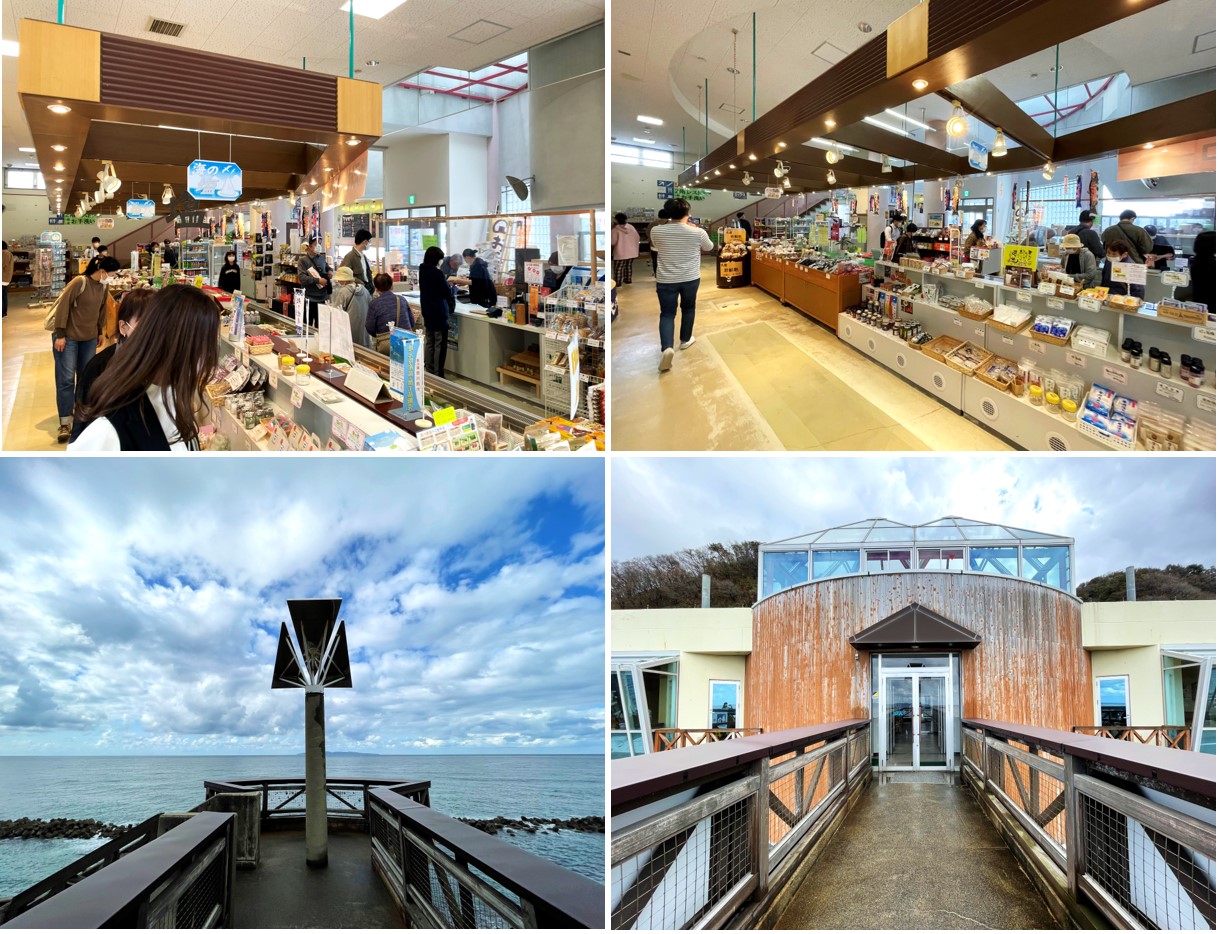Joyful Train in Autumn 2021 #1: KAIRI

Do you love the view of the sea while onboard a train? The landscape of a blue sea that stretches endlessly over the horizon is a view that many people would love to see, and to do so while riding a train is a truly special experience that is hard to put into words. Gazing at the sea is always a therapeutic experience for me, and it's something I always love to do especially when in Japan. What if I tell you that there is a train in eastern Japan that offers a magnificent view of the Sea of Japan (日本海 Nihon-kai) for their passengers? And not just any train, but a Joyful Train too.
KAIRI is the latest addition to JR East’s Joyful Trains line-up, and it plies on the JR Uetsu Main Line (JR羽越本線 Uetsu-honsen), travelling between prefectures Niigata (新潟県) and Yamagata (山形県). What makes KAIRI special is the spectacular scenery while onboard the train, which includes a view of the Sea of Japan and the idyllic rural villages of Niigata Prefecture and the Shōnai Region (庄内地方).

Jak and Emmie's travel route on the KAIRI. (Image credit: JR Times)
My friends Jak and Emmie had the chance to ride the KAIRI a while ago, in the autumn season when the beautiful red and yellow foliage are in full view. To be able to go on this train trip during this season was such an incredible experience, and I want to share with you their journey on this train as it travelled along the coastline of the Sea of Japan.
(Note: this is part one of the four-part Joyful Train in Autumn series, which explores the Joyful Trains that Jak and Emmie took during the autumn season.)
All aboard the KAIRI

Boarding the KAIRI at JR Niigata Station. (Image credit: Japanmase)
Jak and Emmie's journey began from JR Niigata Station (JR新潟駅 Niigata-eki) at 10:11 in the morning. It's their first time riding the KAIRI, and when they first laid their eyes on the train, they were taken aback by its eye-catching blend of deep orange and snow-white hues on its exteriors, and the train's exquisite logo design. The colours represent the sunset and snow respectively, and they are actually related to the local region’s unique environment: Niigata and Yamagata in particular are known for having some of the highest snowfall levels in Japan, and they are regarded as yukiguni (雪国 snow countries). On top of the sleek design and vibrant colours, Jak and Emmie were also pleasantly surprised by how new the train is, since it made its debut just two years ago, in October 2019.
The name “KAIRI” carries a significant meaning too: “KAI” (海) means sea and “RI” (里) means village. As its name suggests, the train’s concept revolves around the beautiful Sea of Japan and the idyllic countryside villages that the train passes by. But that's not all: KAIRI is also known as a "gastronomy train", where passengers can enjoy the region’s finest delicacies onboard.
The KAIRI travels between JR Niigata Station and JR Sakata Station (JR酒田駅 Sakata-eki), but for their journey, their destination was JR Atsumi-Onsen Station (JRあつみ温泉駅 Atsumi-Onsen-eki) instead. The train is made up of four cars in total, each with their own unique characteristics.
Follow Jak and Emmie, as they show you what each car has in store in further detail!
Car 1: Gorgeous views galore

Reclinable seats in Car 1. (Image credit: JR East / Carissa Loh)
Car 1 is the passenger car with a regular two-by-two seat configuration, but a few things grabbed their attention. The interiors feature a stunning orange-white colour combination, and all the seats are reclinable and have generous leg room, which they recognise are essential for a comfortable train ride. But more importantly however, the car features large windows so that passengers can enjoy a full view of the outdoor scenery.
With a train that boasts marvellous scenery that passengers can enjoy right from their seats, it's only a must that the train features large windows, and it didn't disappoint at all. In fact, all the seats on the train offers passengers an unobstructed view of the outdoor scenery; how amazing is that!
Car 2: Compartment comfort

Compartment seats in Car 2. (Image credit: Japanmase)
Car 2 is another passenger car, but here it features cosy compartment seats instead. Such seats are great for small groups of people who value some privacy during their time on the train, as well as families who would like to be seated together. But one unique feature Jak and Emmie noticed was how all the seats are only on one side of the car, and it’s for a simple reason: they are located on the side that directly faces the Sea of Japan. This way, all passengers can have a full view of the glistening sea as the train makes its way along the coastline. How cool is that!
Car 3: Souvenirs at your service

Inside Car 3. (Image credit: Japanmase)
Do you know what my guilty pleasure personally is while travelling in Japan? Buying souvenirs, of course. It’s a way for me to bring back pieces of memories from every travel, and with a ride on a train as exceptional as KAIRI, surely I would like to purchase a memento or two.

KAIRI souvenirs and local specialty snacks sold in Car 3. (Image credit: Japanmase)
In Car 3, there is a souvenir counter where a wide range of KAIRI-themed souvenirs are on sale, such as keychains, handkerchiefs, masks, and more. There are also delectable local specialty snacks sold at the counter like roasted salmon (鮭の焼き漬け Sake no yaki-zuke), Echigo bean crackers (越後の豆菓子 Echigo no mame-gashi), and Murakami matcha powder (村上茶), which Emmie bought for herself. It's really tempting to try them all, don’t you think?

KAIRI-themed keychains (left) and Murakami matcha powder (right). (Image credit: Japanmase)
There’s also an event space inside the car, where performances are conducted on special occasions. But do you know what Jak and Emmie found here? A stamp corner, where passengers can use a rubber stamp with KAIRI’s motif on a piece of paper as a keepsake. Stamps are one of the most popular collectibles among travellers from their train trips, and KAIRI has its own unique stamp on the train. Railway enthusiasts, especially oshi-tetsu (押し鉄 stamp collectors), would not want to miss this nifty corner.

Event space (left) and a stamp corner (right). (Image credit: Japanmase)
Car 4: Delectable delights

Boxed seats in Car 4. (Image credit: Japanmase)
Car 4 is the dining car, and here passengers can relish the best cuisine that Niigata and the Shōnai Region, which is also one of the main highlights of the KAIRI. There are 24 seats here altogether: four 2-person boxed seats, two 2-person window seats, and three 4-person boxed seats. Jak and Emmie went with the window seat because they wanted to enjoy their meals while directly facing the window. Of course, they couldn't contain their excitement at how comfy the seats were.

Their seat of choice: the window seat. (Image credit: Japanmase)
The dining car is only for passengers who have purchased the travel package in advance, which includes the train fare, seat reservation, a course meal, and drinks of your own choice. Passengers can choose to ride the KAIRI without the package, and those with the JR East Pass can have their seats in in Cars 1 or 2.

Their choice of welcome drinks. (Image credit: Japanmase)
Jak and Emmie were amazed at the sheer hospitality of the train staff, who attended to all their needs and requests. The staff introduced the meals that was included with the travel package, but before that, Jak and Emmie were asked to select their welcome drinks. They went with the local soda and green tea set, but the drinks aren’t your regular soda and green tea. The green tea was named Yukiguni Green Tea (雪国緑茶 yukiguni ryokucha), in reference to regions such as Niigata and Yamagata for their high snowfall levels for extended periods of time.
The soda was named Yukiiro Soda (雪色ソーダ) which means “winter-coloured soda”, and it's made with locally grown rice. Interestingly, it had rice particles inside which looked like snow, so it’s like a winter inside a soda bottle! I think it’s unique to see two drinks that are representative of Niigata’s unique climate.

Their meals served in an elegant two-tiered box. (Image credit: Japanmase)
The meals served on the KAIRI are specially prepared by local restaurants in Niigata and the Shōnai Region, and the ingredients are carefully chosen to showcase the different seasons of the surrounding areas. During their trip on the KAIRI, their meals were prepared by Ikinariya (行形亭), and Jak and Emmie were astounded by the exquisite presentation. Their meals were encased in a beautifully designed two-tier lacquered box with an exceptionally crafted wooden cover. The presentation alone impressed them so much, but another surprise awaited them once they opened their boxes.
The food inside, which consisted of seasonal ingredients, looked like a work of art and Jak and Emmie could tell the sheer amount of effort being put into meticulously preparing it. It featured Koshihikari rice (コシヒカリ), salmon roe, grilled mackerel and others, all of which were carefully chosen to reflect the autumn season, from their seasonality to even the choice of colours. Niigata is famous for its rice and seafood, so the meals perfectly showcased the prefecture’s gastronomical excellence.

Enjoying a lavish meal and the beautiful outdoor scenery. (Image credit: Japanmase)

Outdoor scenery from inside the KAIRI. (Image credit: Japanmase)
While savouring their lavish meals, they got to witness vibrant colours before their eyes, from the blue water of the Sea of Japan to the golden rice fields of Niigata's rural countryside. To be able to enjoy delicious food onboard a train with gorgeous sceneries passing by was a kind of privilege that felt special to Jak and Emmie since it’s something they don’t get to do often. A train as exclusive as KAIRI not only allows passengers to enjoy the surrounding region's cuisine and natural scenery, but also demonstrates how train trips can enjoyable, and not just a means to get from one place to another.

Kashimaya Gozen lunch box. (Image credit: Japanmase)
For passengers who plan to ride the KAIRI without a travel package, they can also opt for a lunch box (弁当 bentō). One example of a lunchbox that they can enjoy is by Niigata Kashimaya (加島屋), a Japanese restaurant with a long history of preparing food with local ingredients since its establishment in 1855. It includes local specialty dishes such as king salmon with miso pickles, squid pickled with soya sauce, Shinjo shrimp, and Koshihikari rice from Uonuma. Do note that passengers must make a reservation in advance for this lunch box, by 3 days before departure.
Food is one of the best part of travelling by rail in Japan , so why not consider having this when you hop onboard the KAIRI for your next railway adventure? You will be missing out if you don't try the local delicacies while riding the train.
Spectacular sea-view

JR Kuwagawa Station. (Image credit: Japanmase)
One of the most spectacular views they got to enjoy while riding the KAIRI is the Sasagawa Nagare (笹川流れ), a picturesque 11km coastline that features beautiful sapphire waters, white sandy beaches, and unique rock formations. Passengers can get a panoramic view of the extensive coastline right from the train windows; in fact, the train will even slow down so that passengers can take photos and enjoy the breath-taking view.

KAIRI making a short stop at JR Kuwagawa Station. (Image credit: Japanmase)
Before heading to JR Atsumi-Onsen Station, the train will make a pit-stop at JR Kuwagawa Station (JR桑川駅 Kuwagawa-eki). The station is located right next to the sea, and passengers can get off here and explore the surrounding areas on foot. Most importantly, here was where Jak and Emmie could get up close with the coastline, and enjoy an open view of the sea. The train stops here for 20 minutes, so they had plenty of time walking around and checking out the different places around the station.

Sea-view at JR Kuwagawa Station. (Image credit: Japanmase)
On top of exploring and enjoying the breath-taking view of the sea from JR Kuwagawa Station, there is also a roadside station where passengers can browse and buy local specialty snacks and souvenirs, and an observatory that visitors can climb up to have a vantage point for viewing the sea. But the one Jak and Emmie had been looking forward to the most was a special dessert that can be enjoyed only there.

A roadside station (top) and an observatory (bottom) near JR Kuwagawa Station. (Image credit: Japanmase)
You may have seen all kinds of ice cream, but what about one inspired by the Sea of Japan? At JR Kuwagawa Station, they got to enjoy the Sea of Japan soft-served ice cream (日本海ソフトクリーム Nihon-kai sofuto kurīmu)! This specially-made ice cream is exclusively for passengers of the KAIRI, and is available only at 11:24–11:44 and 16:52–17:21 on the days when the KAIRI is running (the times vary according to the train arrival). That’s right, it’s exclusively for KAIRI passengers, so imagine how lucky Jak and Emmie were to get their hands on this.

Sea of Japan soft-served ice cream. (Image credit: Japanmase)
What’s eye-catching about the ice cream is its blue colour, which is meant to represent the sea. In fact, Jak and Emmie thought that it tasted a bit like the sea! Imagine how refreshing it was to have an ice cream inspired after the sea, right by the sea itself. And best of all, they got to enjoy this right after their lavish meals onboard the KAIRI, so it served (no pun intended) as the perfect dessert for them!
Second servings

More desserts onboard the KAIRI. (Image credit: Japanmase)
If you think Jak and Emmie were done with desserts, you’d be wrong. When they hopped back onto the KAIRI and resumed their journey, they were greeted with another serving of desserts, which came together with the travel package that included the meal earlier on. It featured warabi-mochi (わらび餅) with soya bean flour, Shine Muscat grapes, and figs in apricot jelly. Needless to say, it was extremely delicious and tasted as wonderful as it looked.

Arriving at JR Atsumi-Onsen Station. (Image credit: Japanmase)
At 12:20 in the afternoon, Jak and Emmie finally arrived at their stop at JR Atsumi-Onsen Station, and they bid farewell to the KAIRI. The 2-hour journey onboard the train was one of the most memorable railway experiences they've ever had, where they got to witness spectacular views and taste the most flavourful cuisines that Niigata and the Shōnai Region had to offer. If they ever have the chance to ride the KAIRI again, they would definitely take it, and this time they would like the take the inbound direction from JR Sakata Station to JR Niigata Station.
Closing
Hopping on Joyful Trains such as the KAIRI is one of the most enjoyable and unique ways of travelling by rail, and such trains enable to explore different parts of eastern Japan that many people may have never been to before. Although Jak and Emmie's journey on this KAIRI came to an end, there will be more to come for the rest of their autumn journey throughout eastern Japan.
Stay tuned for my next article, where their railway adventure continues with the Koshino Shu*Kura, a Joyful Train that is specially for sake lovers!
(Insider tip: if you want to ride the KAIRI, you can do so for free with JR East passes below!)
JR EAST PASS (Nagano, Niigata area)

The JR EAST PASS (Nagano, Niigata area) and where you can use it. (Image credit: JR East)
If you are planning to ride the KAIRI or explore Niigata and the Shōnai Region, check out the JR EAST PASS (Nagano, Niigata area), an affordable pass offering unlimited rail travel on JR East lines (including bullet trains and Joyful Trains like the KAIRI) in the valid area for 5 consecutive days at only ¥27,000, and it also covers the KAIRI’s entire route. The JR EAST PASS (Nagano, Niigata area) can be used for automatic ticket gates, and foreign passport holders living in Japan are also eligible to use this pass.
JR EAST PASS (Tohoku area)

The JR EAST PASS (Tohoku area) and where you can use it. (Image credit: JR East)
If you are coming from the Tohoku Region, the 5-day JR EAST PASS (Tohoku area) is only ¥30,000. The JR EAST PASS (Tohoku area) can be used for automatic ticket gates, and foreign passport holders living in Japan are also eligible to use this pass.
(Note: if you are riding the KAIRI with this pass, only the section between JR Sakata Station and JR Murakami Station is covered.)
Header image credit: Japanmase




